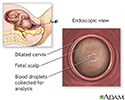Fetal scalp pH testing
Fetal scalp blood; Scalp pH testing; Fetal blood testing - scalp; Fetal distress - fetal scalp testing; Labor - fetal scalp testingFetal scalp pH testing is a procedure performed when a woman is in active labor to determine if the baby is getting enough oxygen.
-
How the Test is Performed
The procedure takes about 5 minutes. The mother lies on her back with her feet in stirrups. If her cervix is dilated at least 3 to 4 centimeters, a plastic cone is placed in the vagina and fit snugly against the scalp of the fetus.
The scalp of the fetus is cleansed and a small blood sample is taken for examination. The blood is collected in a thin tube. The tube is either sent to the hospital laboratory or analyzed by a machine in the labor and delivery department. In either case, results are available in just a few minutes.
If the woman's cervix is not dilated enough, the test cannot be done.
##RemoveMe##
-
How to Prepare for the Test
The health care provider will explain the procedure and its risks. There isn't always a separate consent form for this procedure because many hospitals consider it part of the general consent form you signed at admission.
##RemoveMe##
-
How the Test will Feel
The procedure should feel like a long pelvic exam. At this stage of labor, many women have already had epidural anesthesia and may not feel the pressure of the procedure at all.
##RemoveMe##
-
Why the Test is Performed
Sometimes fetal heart monitoring doesn't provide enough information about the well-being of a baby. In these cases, testing the scalp pH can help the doctor decide whether the fetus is getting enough oxygen during labor. This helps determine whether the baby is healthy enough to continue labor, or if a forceps delivery or cesarean birth might be the best route of delivery.
Although the test is not uncommon, most deliveries do not involve fetal scalp pH testing.
This test is not recommended for mothers with infections such as HIV/AIDS or hepatitis C.
##RemoveMe##
-
Normal Results
Normal fetal blood sample results are:
- Normal pH: 7.25 to 7.35
- Borderline pH: 7.20 to 7.25
The examples above are common measurements for results of these tests. Normal value ranges may vary slightly among different laboratories. Some labs use different measurements or test different samples. Talk to your doctor about the meaning of your specific test results.
##RemoveMe##
-
What Abnormal Results Mean
A fetal scalp blood pH level of less than 7.20 is considered abnormal.
In general, low pH suggests that the baby does not have enough oxygen. This may mean that the baby is not tolerating labor very well. The results of a fetal scalp pH sample need to be interpreted for each labor. The provider may feel that the results mean the baby needs to be delivered quickly, either by forceps or by C-section.
Fetal scalp pH testing may need to be repeated a few times during a complicated labor to keep checking on the baby.
##RemoveMe##
-
Risks
Risks include the following:
- Continued bleeding from the puncture site (more likely if the fetus has a pH imbalance)
- Infection
- Bruising of the baby's scalp
##RemoveMe##
References
Miller DA. Intrapartum fetal evaluation. In: Gabbe SG, Niebyl JR, Simpson JL, et al, eds. Obstetrics: Normal and Problem Pregnancies. 7th ed. Philadelphia, PA: Elsevier; 2017:chap 15.
Nageotte MP. Intrapartum fetal surveillance. In: Creasy RK, Resnik R, Iams JD, Lockwood CJ, Moore TR, Greene MF, eds. Creasy and Resnik's Maternal-Fetal Medicine: Principles and Practice. 7th ed. Philadelphia, PA: Elsevier Saunders; 2014:chap 33.





